![]() Hungary, officially the National Republic of Hungary is a country located in Eastern-Central Europe.
Hungary, officially the National Republic of Hungary is a country located in Eastern-Central Europe.
Geography
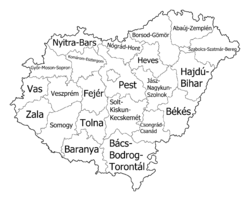
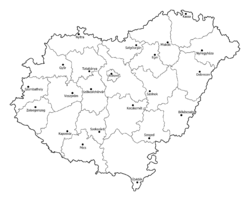
Hungary is located in the eastern part of Central Europe, in the Carpathian Basin. It consists of 22 counties (Vármegyék), 21 county seats (Vármegyeszékhelyek), and the capital (Főváros), Budapest. There weren't any changes implemented on how the counties work, but there've been some geographical changes. Baranya County got back most of the Baranya-triangle, but the county seat still remained Pécs. County Győr-Moson-Sopron got the southern part of Lake Neusiedl. After the reconquering of Vojvodina, a new county was created. The southern part of County Bács-Kiskun (now County Solt-Kiskun-Kecskemét) was ceded to the newly formed county, Bács-Bodrog-Torontál. Baja was temporarily the county seat of County Bács-Bodrog-Torontál, but after the situation was stabilized, it was moved to the biggest city of the county, Újvidék (previously Novi Sad). When Southern Slovakia was reconquered, there were even more border changes inside of Hungary. Győr-Moson-Sopron County regained the towns of Dunacsúd (Čunovo), Oroszvár (Rusovce), and Horvátjárfalu (Jarovce) from Bratislava. The county also gained some more land from Slovakia, including the city of Bős (Gabčíkovo). Komárom-Esztergom County gained a huge chunk of land, as the city of Komárom was once again unified. Pest County gained a small piece of land, including the city of Ipolyság (Šahy). Nógrád County was renamed to Nógrád-Hont County after regaining the sparsely populated historical region of Hont. The only city in the region is Palást (Plášťovce), which experienced a lot of ethnic Hungarian immigration from the south. The county of Borsod-Abaúj-Zemplén was split into two after the reconquest of Southern Slovakia. Borsod-Gömör County gained the region of Gömör, including the strategically important cities of Losonc (Lučenec), Rozsnyó (Rožňava), and Rimaszombat (Rimavská Sobota). The other newly formed county was Abaúj-Zemplén, and the biggest city in the Felvidék, Kassa (Košice) became its capital, gaining the title from the city of Sátoraljaújhely, which held the title while the integration process of Southern Slovakia was still ongoing. A new county was also created which exclusively has territory only in the newly ceded land, as the County of Nyitra-Bars was created. The capital of said county is Nyitra (Nitra). The country is mainly flat, the highest point being Mount Kékes, which is 1014 meters above sea level. The two main rivers of Hungary are the Danube and Tisza, and its biggest lake is Lake Balaton. Hungary is one of the biggest grain exporters of Europe, as the Great Hungarian Plain, occupying the majority of Hungarian land, is one of the best regions in Europe to produce grain, and hold livestock. Hungary is also one of the biggest producers of wine, and because Alcohol is heavily regulated and taxed in Hungary, most wine produced in Hungary is exported, bringing in a lot of money. The Capital and the Western part of Hungary are significantly richer than the Eastern part, although the inequality between the two regions has been increasingly smaller since the new government. The poorest regions are still the ones that have the highest Roma population, most notably the Northeastern part of Hungary, County Borsod-Gömör, County Abaúj-Zemplén, and County Szabolcs-Szatmár-Bereg.
Government
Hungary is a unitary presidential republic, with a very strong national identity. The current ideology of the country is ![]() Ethnic Welfarism
Ethnic Welfarism ![]() , which is a liberal democratic branch of
, which is a liberal democratic branch of ![]() Social Nationalism. Although being criticized as a one-party dominant system, elections are completely free in Hungary, and the current government upholds the values of Liberalism, as a result, there's complete Freedom of Speech, Freedom of the Press, Freedom of Religion, and it also does great effort to respect and uphold the basic human rights, including the right to housing and the right to equality, with restrictions and alleged violations of the Freedom of movement. Shortly after the Great Collapse, Hungary's government and the ruling party, FIDESZ dramatically increased authoritarian measures and mass protests became common. A lot of Hungarians escaped the country to already existing diasporas outside of Hungary (mainly into bordering countries). The government was toppled by a revolution, but no stable government was formed for multiple years. But when it happened, quality of life started to rise again, and the country was stabilizing, but there were still a lot of issues that couldn't be fixed in 4 years, so no party could win 2 consecutive elections, until the current government. Referendums became a lot more common since the new government took power, as the people got more say in how the country works in recent years.
Social Nationalism. Although being criticized as a one-party dominant system, elections are completely free in Hungary, and the current government upholds the values of Liberalism, as a result, there's complete Freedom of Speech, Freedom of the Press, Freedom of Religion, and it also does great effort to respect and uphold the basic human rights, including the right to housing and the right to equality, with restrictions and alleged violations of the Freedom of movement. Shortly after the Great Collapse, Hungary's government and the ruling party, FIDESZ dramatically increased authoritarian measures and mass protests became common. A lot of Hungarians escaped the country to already existing diasporas outside of Hungary (mainly into bordering countries). The government was toppled by a revolution, but no stable government was formed for multiple years. But when it happened, quality of life started to rise again, and the country was stabilizing, but there were still a lot of issues that couldn't be fixed in 4 years, so no party could win 2 consecutive elections, until the current government. Referendums became a lot more common since the new government took power, as the people got more say in how the country works in recent years.
Internal and Foreign affairs
Hungary has a very strict immigration law, while ethnic Hungarians can freely enter the country and get citizenship, only in very specific cases can a foreigner get citizenship. People can freely leave the country permanently. Hungary's economy can be described as a Welfare Capitalist economy with a lot of regulations, intended to help the people, and limit inequality. The nationality law is Ius Sanguinis (right of blood), meaning that only people with at least one ethnically Hungarian parent can become a citizen of Hungary. This applies to every Hungarian living in diasporas, the descendants of Hungarians who were separated from their country in the Treaty of Trianon (for example, Székelys) still hold Hungarian citizenship to this day.
Economy
After the collapse of America, and soon Europe, Hungary started spending a lot more on the military, and defense of the country. Despite the small army size, Hungary boasts one of the highest-quality military forces in Europe, the highest quality in the region. Despite the crisis of Europe, conscription was never implemented in Hungary, so the army is quite small but advanced. Most of the army is inexperienced, as Hungary hasn't fought a war for almost a century now. However, a base of the Hungarian peacekeeping units was once attacked by Ukrainian terrorists, with low casualties on both sides. Peacekeeping units still operate in Ukraine and Poland to this day, although more and more units leave the country as a full-scale conflict in Europe might arise soon. Recently, Hungary has started to use some very advanced weapons, which fully gave the edge to Hungary in the region in terms of quality. As a landlocked nation, Hungary has no navy. The Hungarian airforce is quite inadequate, which ranks Hungary as one of the weaker forces in the air. A huge amount of government revenue goes to welfare policies, as Hungary is ranked as having one of if not the strongest welfare state and social safety net, and is constantly ranked highly in quality of life.
Diplomacy
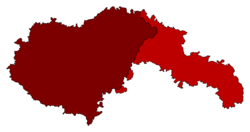
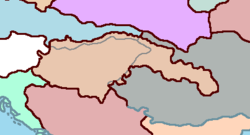
Hungary is in a very unique diplomatic position, because of the democratic, nationalistic, and socialistic elements of the country. As a globalist country in principle, the country is very open to diplomatic relations, trying to be a mediator between ideologically vastly different countries. However, one of the main principles of the country's ideology is Ethnopluralism and Hungary's main goal on the global stage is to unite all Hungarians in the same state. After regaining South-Neusiedl, Southern Slovakia, Vojvodina, the Baranya-triangle, and Medimurje, Hungary still has claims in the Dacian Confederation (Northern Transylvania, Southwest Transcarpathia, Arad). On the official Polish-Hungarian Friendship Day, Hungary and Poland signed the Treaty of Friendship, conciliation and arbitration between Hungary and Poland (Lengyel-magyar örök barátsági szerződés). This treaty ensures free trade between the two countries, as well as economic, technological, and scientific cooperation, and a mutual defensive pact against any European aggressor. Hungary also signed a pact with the New Italian Republic, called the Italo-Hungarian Pact, and a pact with the New Roman Empire, called the Roman-Hungarian Pact, both economic pacts and mutual defensive pacts against certain countries. Hungary also signed a pact with Byzantium, called the Holy Crown Alliance, which is an economic and technological pact between the two nations, and it also contains a mutual defensive pact against a common enemy. Hungary has also started to financially support the SatellaGlobe Project, without joining the organization. Recently, Hungary signed a pact with Greater Illinois in the capital city, Budapest. It is an economic, trading, and technological pact, and a mutual defense pact as well. Hungary also joined The International Red Cross organization right after it was created, as Hungary is sending aid to both Polish countries during times of conflict.
Laicism
The Ethnic Welfarist government has a strong Laicist stance on religion, which doesn't sit well with the country that used to be one of the most religious ones in Europe. From reforms like making the teaching of Evolution mandatory in all public schools in Biology classes, while the teaching of Creationism is only optional, and must be taught in Literature classes as an outdated concept and theory, to changing the National Anthem of Hungary from Himnusz to Szózat, which is a far more nationalist and less religious hymn than the previous one, Atheism quickly started to spread across Hungary, with Budapest being the center. Nowadays, Budapest is one of the largest cities by an atheist population, with new surveys and polls claiming that more than 90% of the city is irreligious. While Christianity as a whole is still the majority in Hungary, no denomination has a larger base than Atheism, and Atheism is still spreading across the population at a very high rate, especially in county capitals, and other big cities. Because of that, smaller protests by Christians (mainly Catholics) have been more and more common, and tensions are at an all-time high. It could take only one incident to warrant mass protests from the Catholic population. But the government holds a Secular position, with the Freedom of Religion fully guaranteed to everyone, it's unlikely that government action could spark a large protest anytime soon. The Catholic "Kereszténydemokrata Néppárt" (KDNP) is the strongest opposition party in Hungary by a big margin, which shows that a big portion of the population is unhappy with the government's policies regarding religion.
Dél-Felvidék

When the government of Slovakia collapsed, the nation fell into anarchy. Hungarians outside of our border were suffering under no rule and lynching was very common in Hungarian-majority towns. As there was no government, Hungary seized the opportunity and occupied the southern part of Slovakia (Dél-Felvidék), which was majority Hungarian. There was some resistance, but the casualty remained very low on both sides. Dél-Felvidék was quickly integrated into Hungary since it was mainly ethnically homogeneous. The region was divided, and some counties regained their historical land, like the County of Győr-Moson-Sopron (Győr-Moson-Sopron vármegye), the County of Komárom-Esztergom (Komárom-Esztergom vármegye), the County of Pest (Pest vármegye), and the County of Nógrád-Hont (Nógrád-Hont vármegye), formerly called the County of Nógrád (Nógrád vármegye). Two new counties were created as well, one of them is the County of Nyitra-Bars (Nyitra-Bars vármegye), which only consists of land in the region of Dél-Felvidék. Its capital is Nyitra (Nitra). The County of Borsod-Abaúj-Zemplén (Borsod-Abaúj-Zemplén vármegye) was split into two new counties, and both were given huge chunks of historic land from the region of Dél-Felvidék. These counties are the County of Borsod-Gömör (Borsod-Gömör vármegye), and the County of Abaúj-Zemplén (Abaúj-Zemplén vármegye). Kassa (Košice) became the county capital of the latter county. A lot of Slovakians migrated north, but there is still a sizable Slovakian population living in the region, and Hungary wishes to cooperate with the nation of Czechoslovakia in this regard.
Vajdaság

After the country stabilized from the Great Collapse, much of the Balkans was still an active battleground, where no government could form. Taking advantage of this, Hungary crossed the border and occupied Vojvodina, or in Hungarian, Vajdaság, to protect the Hungarian population living there from aggression and terrorist attacks. The army faced no opposition from the villages, and only a few skirmishes broke out in the larger cities, with a sizeable Serbian minority, such as in Novi Sad (now Újvidék), Subotica (now Szabadka), and Sombor (now Zombor). No battles or serious rebellions happened. Vajdaság was successfully integrated into Hungary relatively quickly, as the majority of the land gained was ethnically Hungarian. A lot of Serbians fled the area, but a lot of them also remained, tired of the constant war. The region was divided into two, the much smaller, western part, which was part of Croatia before the Great Collapse was annexed by the County of Baranya (Baranya vármegye), and the remaining land became a new county, called the County of Bács-Bodrog-Torontál (Bács-Bodrog-Torontál vármegye), while the southern part of County Bács-Kiskun was ceded to the new county based on historical reasons. The county was renamed to County Solt-Kiskun-Kecskemét (Solt-Kiskun-Kecskemét vármegye). The biggest city in the ceded region, Baja became the county capital for a brief period, until the situation stabilized. Then the capital was moved to Újvidék. The previously Croatian part of Vajdaság experienced a sizeable immigration from people in Budapest wanting to move to more rural areas, which was promoted by the government. After the establishment of the Balkan Union, Hungary wishes to cooperate with the newly formed Union, to help Serbians and Croatians stuck in Vajdaság reach the Serbian and Croatian homeland, now that it is not war-ridden anymore.
Muravidék
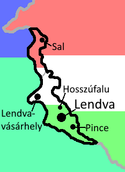
After the border incident with Dacia, war almost broke out between the two countries. Luckily, through the path of diplomacy, no wars broke out, and the conflict was resolved peacefully. However, Hungary sent an ultimatum to Istria to declare neutrality and break the pact with Dacia. And for reparations, Hungary demanded the region they've been claiming for a long time, Midmurje. In the Treaty of Pécs, Istria accepted Hungary's demands, and the region was ceded to Hungary. This region is majority-Hungarian, with a population of around 10 thousand. The biggest and only city is Lendva. Hungary offered support to Istria and also asked for cooperation in a very small-scale population exchange program as well. The newly regained region has been split into two counties, the northern part became part of the County of Vas (Vas vármegye), while the southern part became part of the County of Zala (Zala vármegye). The treaty also meant the annexation of a few towns bordering the County of Somogy (Somogy vármegye), namely Décseszentpál (Ferdinandovac), Bród (Brodić), and Kalinóc (Kalinovac).
Demographics
| Ethnicity | % |
|---|---|
| 92% | |
| 3% | |
| 1% | |
| 1% | |
| 1% | |
| 1% | |
| 1% |
| Religion | % |
|---|---|
| 45% | |
| 42% | |
| 8% | |
| 3% | |
| 2% |
